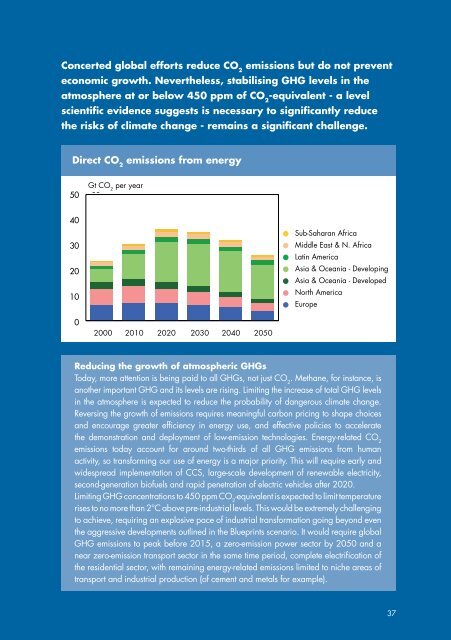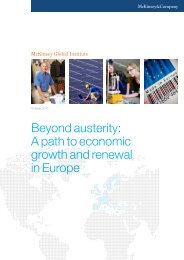Shell energy scenarios to 2050 - Manicore
Shell energy scenarios to 2050 - Manicore
Shell energy scenarios to 2050 - Manicore
You also want an ePaper? Increase the reach of your titles
YUMPU automatically turns print PDFs into web optimized ePapers that Google loves.
Concerted global efforts reduce CO 2emissions but do not preventeconomic growth. Nevertheless, stabilising GHG levels in theatmosphere at or below 450 ppm of CO 2-equivalent - a levelscientific evidence suggests is necessary <strong>to</strong> significantly reducethe risks of climate change - remains a significant challenge.P37Direct CO 2emissions from <strong>energy</strong>Gt CO Gt 2 CO per 2 yearper year50 5040 40302010302010Sub-Saharan AfricaAfricaMiddle Middle East East & N N. & Africa N AfricaLatin Latin AmericaAmericaAsia Asia & Oceania & - Developing- Asia Asia & Oceania & - Developed- North North AmericaEuropeEurope0 02000 2000 2010 2010 2020 2030 2030 2040 2040 <strong>2050</strong><strong>2050</strong>Reducing the growth of atmospheric GHGsToday, more attention is being paid <strong>to</strong> all GHGs, not just CO 2. Methane, for instance, isanother important GHG and its levels are rising. Limiting the increase of <strong>to</strong>tal GHG levelsin the atmosphere is expected <strong>to</strong> reduce the probability of dangerous climate change.Reversing the growth of emissions requires meaningful carbon pricing <strong>to</strong> shape choicesand encourage greater efficiency in <strong>energy</strong> use, and effective policies <strong>to</strong> acceleratethe demonstration and deployment of low-emission technologies. Energy-related CO 2emissions <strong>to</strong>day account for around two-thirds of all GHG emissions from humanactivity, so transforming our use of <strong>energy</strong> is a major priority. This will require early andwidespread implementation of CCS, large-scale development of renewable electricity,second-generation biofuels and rapid penetration of electric vehicles after 2020.Limiting GHG concentrations <strong>to</strong> 450 ppm CO 2-equivalent is expected <strong>to</strong> limit temperaturerises <strong>to</strong> no more than 2°C above pre-industrial levels. This would be extremely challenging<strong>to</strong> achieve, requiring an explosive pace of industrial transformation going beyond eventhe aggressive developments outlined in the Blueprints scenario. It would require globalGHG emissions <strong>to</strong> peak before 2015, a zero-emission power sec<strong>to</strong>r by <strong>2050</strong> and anear zero-emission transport sec<strong>to</strong>r in the same time period, complete electrification ofthe residential sec<strong>to</strong>r, with remaining <strong>energy</strong>-related emissions limited <strong>to</strong> niche areas oftransport and industrial production (of cement and metals for example).37



